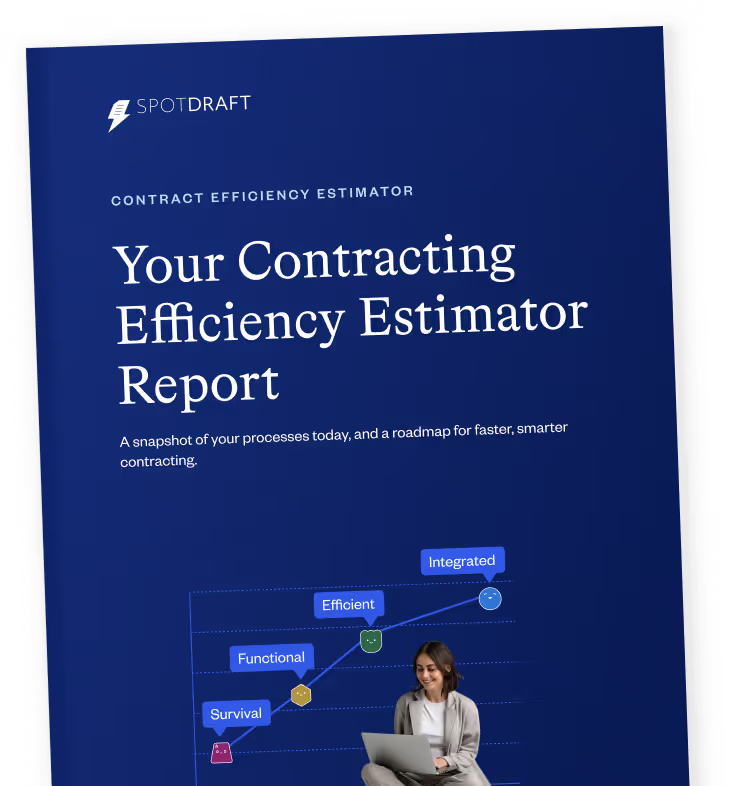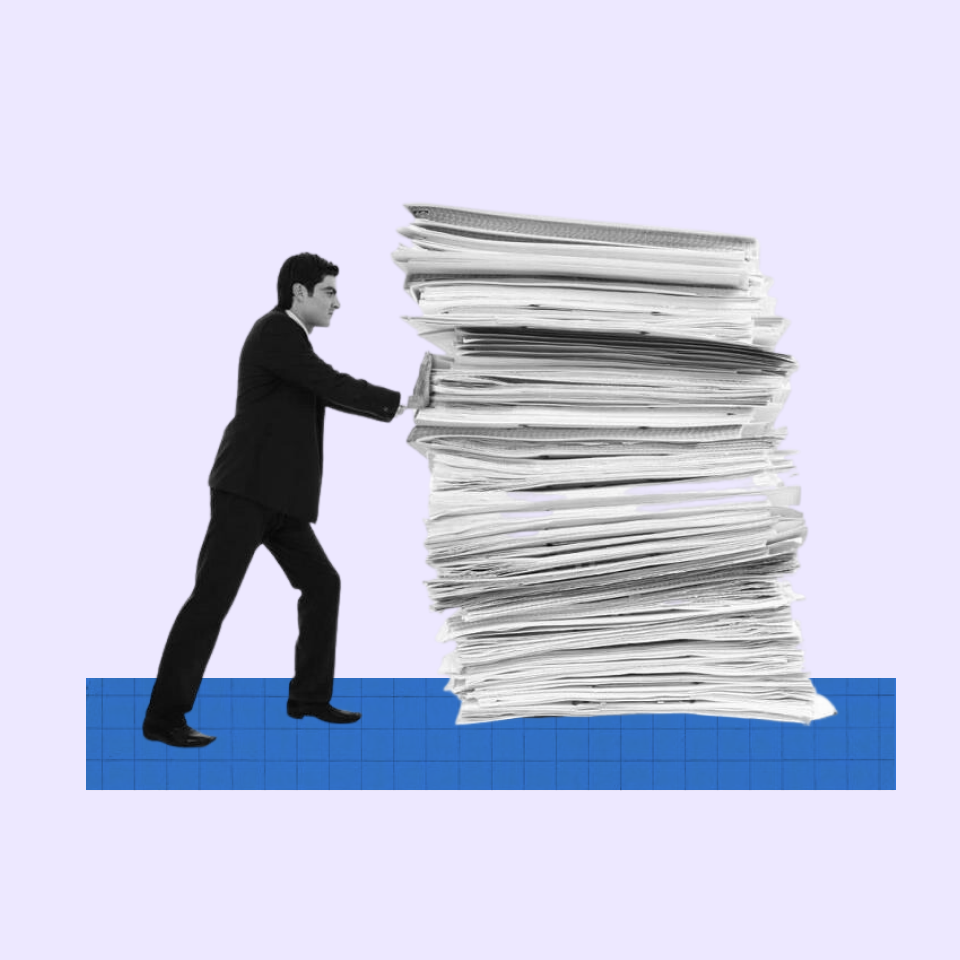On an average, an in-house lawyer spends about 15-40% of their time on tasks that don’t even need a lawyer. Not only does this lose the business money — about $2.7 million for teams of 20 lawyers — but can also lead to dissatisfaction and burnout. Moreover, this time could have been spent much more productively on high leverage tasks critical to the legal function and business.
That’s why it’s essential to have a strong contract administration plan in place that allows for greater efficiency and productivity while streamlining and delegating routine tasks that lawyers don’t need to be spending their time on.
If you’re aiming to enhance the contract administration process at your organization, then this guide has all you need. Read on for a comprehensive overview of successful contract administration, actionable steps you can put into practice immediately, and advice from leaders within the legal industry.
What is contract administration?
Contract administration is the ongoing management and tracking of contracts, from planning and executing contracts to change and compliance management, contract monitoring, KPI tracking, etc.
Contract administration vs. contract management — What’s the difference?
Contract management and contract administration always go hand in hand. Though both govern the contract lifecycle and are often used interchangeably, the administration facet of a company’s contracting motion majorly deals with the day-to-day contract planning, organization, and tracking.
This includes understanding the scope of what each stakeholder wants out of the contract, preparing commercial contracts, laying down contract duration and negotiating terms, reviewing and updating contracts, etc.
On the other hand, contract management is the process that governs the A-Z creation, execution, and reporting of contracts.
In some companies, contract management encompasses the administration phase of contracts. In others, especially for smaller companies, the two processes are carried out by the same people and are indistinguishable from each other.
Who is involved in the contract administration process?
The contract administration process is typically owned by a contract administrator. However, depending on the headcount of the legal team, it may be a contract manager, a paralegal, and other members of the legal department that take on some or all of these responsibilities.
Aside from the legal team, the following stakeholders are typically involved:
- Business or commercial teams: These are internal stakeholders who depend on effective contract administration to meet their quotas, close deals, track revenue, etc. Sometimes these individuals also become responsible for administrative tasks when working with self-serve contracts.
- Ops team and project managers: These stakeholders are responsible for a lot of the tasks around obligations management and execution of the contract.
- Counterparties: A crucial part of the contract administration process is communicating and negotiating with the counterparties of contracts, such as suppliers, vendors, partners, customers, and more.
Contract administration is majorly a responsibility of the legal team, who must ensure efficiency, flexibility, and visibility in the process. Unfortunately, much of the work that falls under contract administration are repetitive, low value tasks that eat into the legal team’s time and hinder them from working at their full potential.
In the following sections, we’ll cover how in-house lawyers can automate and optimize contract administration for minimal manual effort.
7 stages of contract administration

Contract administration usually includes the following stages:
#1 Contract planning
At this stage, the contract administrator or relevant legal team member identifies the scope and objectives of the contract as well as the terms and conditions. On the basis of these, they generate a contract that will govern the business relationship.
#2 Contract review
The legal team reviews the contract to ensure that it is compliant with internal policies, consistent with their standard language, and compliant with applicable laws and regulations.
#3 Contract approvals and signature
Once the legal team okays the contract, it is then routed for approvals to relevant internal and external stakeholders, such as the finance team, business leaders, counterparties, etc. This stage also involves contract collaboration and negotiation to ensure both parties are satisfied with the terms of the business relationship. Finally, after all stakeholders have approved the contract, it is routed for signatures.
#4 Contract monitoring
Once a contract is executed, the contract owner must monitor the contract on an ongoing basis and ensure all obligations are fulfilled on both sides. This includes tracking important contract dates and events, extracting key metadata and information from the contract, and doing periodic performance reviews. This stage also involves tracking performance of contracts against established KPIs and metrics.
#5 Contract amendments and changes
After the contract’s executed, one or all of the parties may require amendments to the contract due to changes in the internal policies, project scope, or other factors.
#6 Contract renewal or termination
It’s crucial to keep track of upcoming contract renewals or terminations to ensure there are no unwanted auto-renewals and there is enough time to follow up with all the parties to see if the contract should be renewed or terminated.
#7 Contract closeout
Once a contract is deemed obsolete and terminated, the contract is archived within the contract repository, alongside all important documentation. Any final activities related to the closing of the contract also must be concluded by this stage, such as billing and payment, delivery of finished goods or work, etc.
6 steps to prepare a successful contract administration plan

It’s critical to have an efficient contract administration plan in place to govern the contracting process at your organization. Here’s a step-by-step guide to help you prepare a contract administration process that actually works:
#1 Define the scope and objectives
The first thing to do when working on improving or preparing a contract administration plan is to clearly define the scope of the project, your expectations from the exercise, and the stakeholders involved in the contracting process at your organization.
#2 Lay down roles and responsibilities
For all the stakeholders involved in the contracting process, both legal and non-legal, identify and optimize the roles and responsibilities in a clear, repeatable manner that takes into account the blockers of the previous process.
#3 Establish communication protocols
An important aspect of effective contract administration is communication. Without the right communication channels and effective collaboration between stakeholders, contract administration can quickly become a nightmare. Open channels of communication and ensure that everyone is aware of the new processes as well as their responsibilities.
#4 Establish performance metrics
Performance metrics are key to measuring the success of your contract administration plan. Identify relevant KPIs and metrics, and lay down expected ROI in quantifiable terms that are easy to measure, understand, and communicate. This may be turnaround times, revenue enabled, etc.
#5 Develop monitoring and reporting procedures
“Try to glean as much info about what causes friction as possible. Your biggest wins will come from addressing these knowledge gaps or hesitancies that are blocking/slowing deals.”
— Sue So
Head of Legal, Hopin
Create a process around measuring and reporting around the contract lifecycle, contract performance, legal productivity, risk management, and more. This will ensure visibility and accountability for all stakeholders involved in the process.
#6 Onboard a CLM or contract repository
“Leveraging a CLM has been key because it has reduced a lot of friction from handoffs between legal and business. Rather than going back and forth over email, Slack, Word, Zoom, DocuSign, and a whole tech stack, the CLM acts as a single source of truth.”
— Jonathan Franz
Head of Legal, Crunchbase
It’s essential to ensure quick and easy access to contracts and related information for all stakeholders. This is to prevent contract audits from becoming a time-consuming process, ensure legal teams don’t have to spend half their time searching for lost contracts, and ease cross-functional communication. Implementing a CLM or contract repository will help streamline contract storage, search, and retrieval.
6 tips and best practices to immediately improve contract administration at your organization
Looking for some quick wins that will help you streamline your contract administration? Follow the tips below:
#1 Centralize your contracts in a searchable database
Creating a centralized repository or database is the easiest way to get some time back into your legal team’s calendar and ensure stakeholders have visibility to contract status and information. If you don’t have the budget for a CLM right now, you can also create a DIY contract repository using cloud-based folders and a Google Sheet.

Grab SpotDraft’s Contract Management and Tracking Template here.
#2 Standardize your contracts and language
Identify high-volume contracts and templatize them to allow for quick and self-serve contract generation. This will help streamline contract creation, review, and negotiation as well as create consistency within your contracts.
#3 Create a playbook for your contracts
To ensure consistency across all your contracts, create a playbook for your high-volume and high-priority contracts, with standard and fallback language for all common clauses. This will enable business teams to independently negotiate contracts and also ensure compliance.
Also Download: SpotDraft’s NDA Negotiation Playbook Template
#4 Automate contract management
Legal teams are often buried under repetitive, tedious tasks that can easily be automated through a contract management software. Onboarding a CLM software or creating one using custom solutions such as project management tools can help you eliminate such work and ensure Legal gets time for more productive work.

#5 Train your contract managers and stakeholders
Often, legal teams have processes and tools in place to govern the contract administration and management process — but adoption across the board remains low. This could be because of stakeholders unable to figure out how the process works or unaware that it even exists. In such a case, holding training sessions with your team and stakeholders can help you drive adoption and ensure process efficiency.
How contract management software can strengthen your contract administration
The smartest legal teams use specialized tools like CLMs to help them reduce contracting burdens and create scalable processes. Here’s how a contract management software like SpotDraft will help you streamline your contract administration process:
#1 Enabling commercial teams to work independently
Commercial contracts are often the biggest drain on legal resources — yet these are also some of the easiest contracts to standardize. A CLM can help you create templates for your high-volume contracts and enable business teams to self-serve new contracts within minutes.

#2 Making contract data accessible
With the right CLM, you can migrate your legacy contracts onto one platform and create a scalable repository for all your contracts. This enables easy access to your contract data in a single dashboard, without having to switch between platforms and communication channels.

#3 Automating contract tasks and collaboration
Manually collecting approvals or tracking contract tasks and events is a thing of the past. CLM software can help you automate the entire contract lifecycle, from notifying stakeholders of pending approvals and requests to tracking and sending out reminders for upcoming contract renewals and expiry.

#4 Providing greater version control
“Another problem we face in contract management is version control - different departments may be using old templates and rolling contracts out manually. We want to implement a CLM solution to have better visibility into our contract pipeline, especially when our business is scaling in different countries.”
— Juliette Thirsk
Head of Legal at Peach Payments
CLMs like SpotDraft help centralize all your contract collaboration and negotiation in one place, making it easy to track all your contract versions as well as identify the latest version. Moreover, many CLMs offer audit logs and history to allow for greater accountability and contract tracking.

#5 Facilitating real-time reporting
“Most C-Suite executives bank on data and hard metrics and not word-of-mouth. When you have certain metrics that shed light on how legal teams have contributed to growing the revenue stream of the company, it becomes easier for the GC to make business cases.”
— Gitanjali Pinto Faleiro
General Counsel, Company Secretary & CCO at Greenhill & Co.
With a CLM like SpotDraft, generating reports becomes as easy as clicking on a few buttons. You can select filters, run custom queries, and download personalized reports in seconds as opposed to spending hours on ad-hoc report requests. SpotDraft also offers an insights dashboard, which provides you greater insight into your contract processes, blockers, productivity, and more.

Host your contract administration process on SpotDraft
“SpotDraft makes contract lifecycle management a breeze! As a contracts manager, I enjoy how SpotDraft makes it easy for our users to generate and customize contracts, send contracts for signatures, and revisit them when needed. Not only is the tool intuitive and easy to use – the entire SpotDraft team provides exceptional support.”
— Charlene Nyugen, Notion
Ready to revolutionize your contract administration? Get in touch with the experts at SpotDraft to learn how we can help.


.avif)







